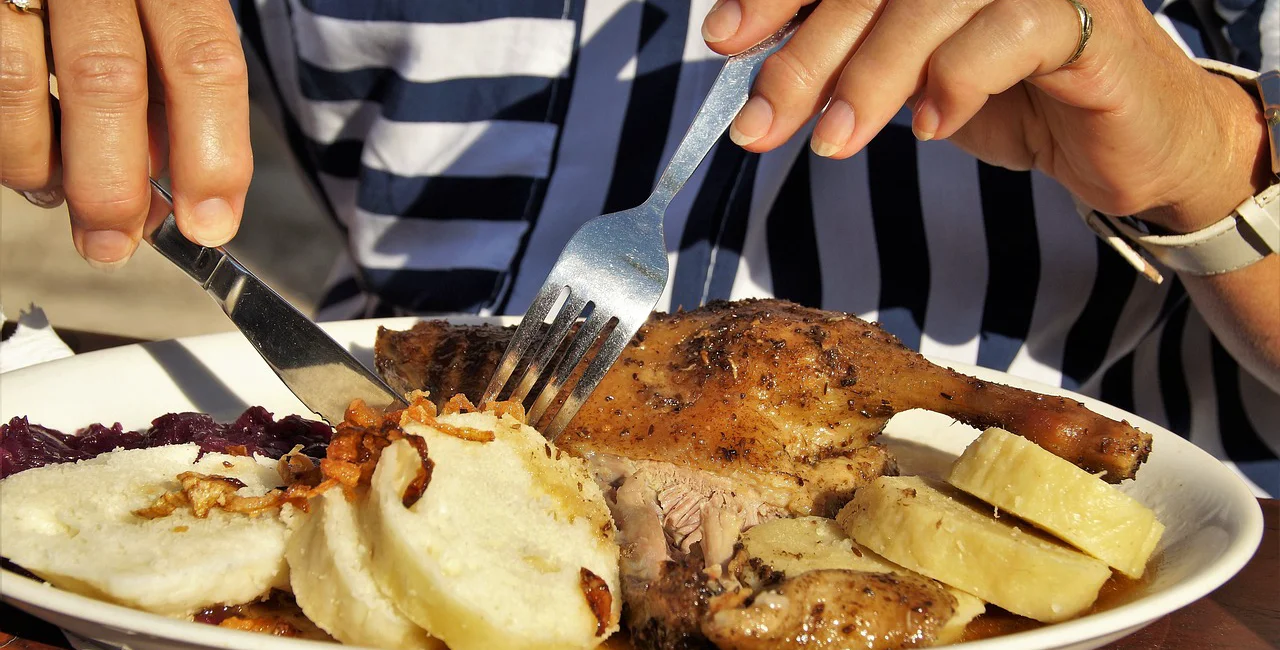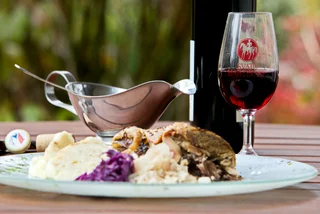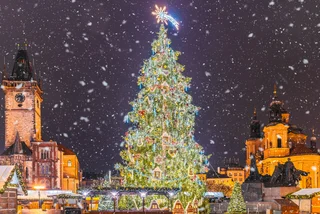St. Martin’s Day, which falls on Nov. 11, is the first day when wine from this year’s harvest bearing a special trademark can be sold in Czechia, starting at 11:11 a.m sharp. Traditionally, the wine is consumed alongside a meal of roasted goose. Many local eateries will offer special goose menus, and there will be public feasts over the weekend (read on for our recommendations).
This year, a record amount of Svatomartinské vino (as St. Martin’s Day Wine is known in Czech) will hit the market – about 2.35 million bottles comprising 304 different wines from 74 winemakers, up from 2.2 million bottles last year.
Unlike France's Beaujolais nouveau, a young red wine that hits the world market on the third weekend of November, Svatomartinské vino can be any color and can come from several varietals of grape. This year, whites account for 143 of the wines, followed by 91 rosés and 70 reds.
High standards for quality
Not just any new Czech or Moravian wine can sport the Svatomartinské (St. Martin) designation or associated logo depicting St. Martin riding a horse. These are trademarks overseen by Vinařský fond, a Brno-based organization that promotes Czech wine, educates the public, and preserves wine heritage.
Professional wine tasters met in the Vinařský fond’s Center of Excellence Valtice to evaluate this year’s wines. About 15 percent of the submitted wines did not meet the criteria, while last year only 8 percent were rejected.
Vinařský fond director Jaroslav Machovec said that consumer expectations for quality have increased, and the evaluation process now ensures sure that the young wines will have the typical characteristics that have made them so popular.
“St. Martin wine is not only a symbol of autumn, social events, and gastronomy, but it is also a sign of quality,” Machovec said in a press release.
These wines should be light, fresh, and aromatic. They are intended to be consumed within the next few months as they do not improve with age. This is why about 87 percent of bottles will have a screw cap, which is more practical than a cork.
What to expect from this year's Svatomartinské vino:
- White wines from the Müller Thurgau grapes will be mainly peach, grapefruit or with a subtle nutmeg. Veltlínské červené rané will have slightly raisin-honey tones with banana undertones, and in Muškát moravský we have the aroma and taste of tropical citrus fruits such as limes and tangerines.
- Rosé wines will be pleasant, fruity, and fresh, with notes of cherries, ripe sour cherries, and a delicate creaminess.
- Red wines will also be fresh and fruity. Svatovavřinecké will have notes of wild plum and dried fruit, while Modrý Portugal will have a floral scent of peonies, meadow flowers, and soft notes of forest fruit. Source: Vinařský fond
What to eat
The typical St. Martin's Day meal consists of a Czech soup called kaldoun, slow-cooked goose confit with red and white cabbage, usually accompanied by dumplings or potato pancakes. A small dessert is often included. There are many variations, with some places offering a duck or goose pâté instead of or in addition to the soup.
There is usually a choice of red or white wine. The outdoor festivals will undoubtedly feature this year's Svatomartinské vino. The wine offers at restaurants and pubs vary, with a few – especially those offering a menu before Nov. 11 – not offering the new wine.
Goose entrees this year will be between CZK 600 and CZK 700 on average at restaurants, though some pubs are a bit cheaper. Last year it was not uncommon to find a goose main course for CZK 500. Not only are restaurants hit with higher energy costs, but there is a shortage of geese this year due to 24 percent fewer of them being raised on Czech farms this year. Restaurateurs say that compared to last year, goose dishes will be up to 30 percent more expensive. Wine prices should not rise so significantly due to the record supply.
Going with the crowd
There are several large public festivals. Wine, goose, and music will be at Naplavka between Palackého náměstí and the railway bridge on Nov. 11 from 11 a.m. to 10 p.m.
The Botanical Garden in Troja will let people sample three different wines starting at 11 a.m. on Nov. 11, but there is no goose meal planned.
Large celebrations with wine and goose will be held on Nov. 12 at the farmers markets at Řezáčovo náměstí in Prague 7, Kubánské náměstí in Prague 10, and náměstí Jiřího z Poděbrad in Prague 3. There is also a family-friendly event on Nov. 12 at the National Museum of Agriculture in Letná.
Having a sit-down meal
Many restaurants also will be having events, either for one day or several. We've rounded up some of the highlights. Reservations are recommended so you won't be disappointed once you arrive at the restaurant for your feast.
Červený Jelen in New Town offers their goose and wine menu, created by chef Marek Fichtner, from Nov. 11 to 20. You can also order a whole goose but must reserve it in advance.
The Twisted Fig in Karlin has a goose menu already underway and lasting until Nov. 11, paired with select wines. It is available for lunch as well as dinner.
Just outside of Prague, Zámek Štiřín has a full goose menu from Nov. 11 to 30. It must be ordered a day in advance by phone or email.
Several restaurants in the Ambiente chain have traditional goose feasts until Nov. 13 at Lokál venues, U Kalendů, Café Savoy, and Kantýna plus some non-traditional takes on the meal at Čestr, Eska, Pasta Fresca, and Pizza Nuova. People who want to cook goose at home can find one at Naše maso.
Ambiente's Kuchyň has a goose and duck feast for the next three weekends. The first is already full, but you can make reservations (at least 24 hours in advance) for Nov. 17–20 and Nov. 24–27.
The Augustine Restaurant and Bar in Malá Strana has its special menu from Nov. 11 to 13.
Goose dishes are available throughout the month of November at Restaurace Mlýnec, near Charles Bridge.
The Farm Letná offers its own take on the traditional meal, with shredded duck leg as the main course and chicken soup or chicken liver as a starter, and wine or beer. It is available from Nov. 11 to 13.
Chateau St. Havel in Prague 4 has a fancy four-course menu from Nov. 11 to 13. The main course of baked goose leg also includes sauerkraut soufflé, among other side dishes.
The flexitarian restaurant Spojka Karlín has goose with potato rosti and cabbage puree until Nov. 11 as a lunch or dinner special.
While generally known for craft beer, Pivovarský dům Benedict in New Town delves into goose and wine starting Nov. 11 and lasting until Nov. 15 or when it runs out.
Malostranská beseda in Malá Strana offers goose in a traditional pub setting on Nov. 11.
Another old-school pub, Restaurace U Šumavy in New Town has its menu until Nov. 13.
A popular spot in the Bubeneč area, Na Slamníku has several goose options including shredded goose with potato pancakes from Nov. 11 to Nov. 13.
But why the goose?
St. Martin of Tours, according to Catholic tradition, was a fourth-century Roman soldier who converted to Christianity as a young man. He was reluctant to be appointed the bishop of Tours, a city in what is now France, so he hid out in a barn. A legend says the cackling of the geese gave his location away, and he has been associated with geese ever since.
He died on Nov. 8, 397, and was buried three days later, making Nov. 11 his feast day as well as a day of bad luck for geese in not only Czechia but also Germany and Sweden, which have similar St. Martin's Day feasts.












 Reading time: 6 minutes
Reading time: 6 minutes 
























